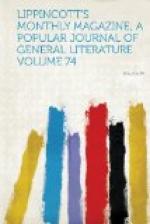The Chinese grocery-stores are museums to the American. There are strange dried roots, strange dried fish, strange dried land and marine plants, ducks and chickens, split, pressed thin and smoked; dried shellfish; cakes newly made, yellow, glutinous and fatty, stamped with tea-box characters; and great earthen jars filled with rottenness. I speak correctly if perhaps too forcibly, for when those imposing jars are opened to serve a customer with some manner of vegetable cut in long strips, the native-born American finds it expedient to hold his nose. American storekeepers in the mines deal largely in Chinese goods. They know the Mongolian names of the articles inquired for, but of their character, their composition, how they are cooked or how eaten, they can give no information. It is heathenish “truck,” by whose sale they make a profit. Only that and nothing more.
A Chinese miner’s house is generally a conglomeration of old boards, mats, brush, canvas and stones. Rusty sheets of tin sometimes help to form the edifice. Anything lying about loose in the neighborhood is certain in time to form a part of the Mongolian mansion.
When the white man abandons mining-ground he often leaves behind very serviceable frame houses. John comes along to glean the gold left by the Caucasian. He builds a cluster of shapeless huts. The deserted white man’s house gradually disappears. A clapboard is gone, and then another, and finally all. The skeleton of the frame remains: months pass away; piece by piece the joists disappear; some morning they are found tumbled in a heap, and at last nothing is left save the cellar and chimneys. Meantime, John’s clusters of huts swell their rude proportions, but you must examine them narrowly to detect any traces of your vanished house, for he revels in smoke, and everything about him is soon colored to a hue much resembling his own brownish-yellow countenance. Thus he picks the domiciliary skeleton bare, and then carries off the bones. He is a quiet but skillful plunderer. John No. 1 on his way home from his mining-claim rips off a board; John No. 2 next day drags it a few yards from the house. John No. 3 a week afterward drags it home. In this manner the dissolution of your house is protracted for months. In this manner he distributes the responsibility of the theft over his entire community. I have seen a large boarding-house disappear in this way, and when the owner, after a year’s absence, revisited the spot to look after his property, he found his real estate reduced to a cellar.
John himself is a sort of museum in his character and habits. We must be pardoned for giving details of these, mingled promiscuously, rather after the museum style. His New Year comes in February. For the Chinaman of limited means it lasts a week, for the wealthy it may endure three. His consumption of fire-crackers during that period is immense. He burns strings a yard in length suspended from poles over his balconies. The uproar and sputtering consequent on this festivity in the Chinese quarter at San Francisco is tremendous. The city authorities limit this Celestial Pandemonium to a week.




